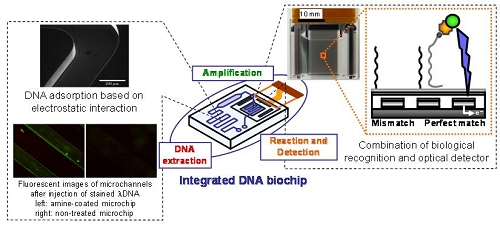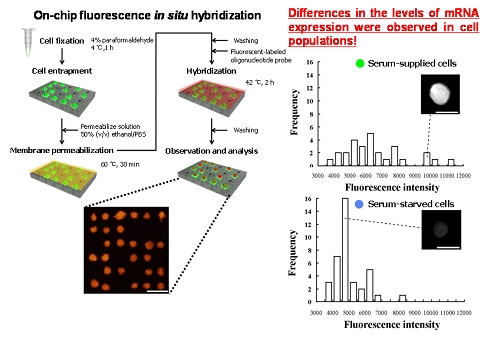![]()
Microfluidic technology

Introduction
In recent years, semiconductor integrated IC technology and microfabrication technology have been applied in biotechnology. One of the application of these technologies is BioChips.
BioChips are miniaturized devices designed for bio-molecular analysis and provide many advantages including their low cost and high-throughput applicability. In our laboratory, we focus on the development of all-in-one Biochips compatible for various diagnostic applications.
DNA Extraction from Whole Blood Based on Electrostatic Interactions
A cascading hyperbranched polyamidoamine dendrimer was synthesized on the surface of BMPs to allow enhanced extraction of DNA from fluid suspensions. Characterization of the synthesis revealed linear doubling of the surface amine charge from generations one through five starting with an amino silane initiator. The dendrimer modified magnetic particles were then used to carry out magnetic separation of DNA. The positively charged dendrimer modified magnetic particles bind DNA through electrostatic interactions resulting in the increase in binding and release efficiencies of the particles with the increase in the number of generations. This extraction method enabled us to purify 33 ng of genomic DNA from 1 mL of blood. We have also developed a fully automated system to fully utilize this technique in high-throughput genomic DNA extraction.
DNA Amplification on Micro-Chip
Subsequent to the development of the DNA extraction method, we proceeded with the construction of a micro-chip for DNA extraction and amplification. An amine-coated micro-chip was constructed for DNA binding assay where the binding capacity of the micro-chip reached to 6 ng of DNA. We then conducted DNA amplification of the alcohol dehydrogenase 2 (ALDH2) gene (176 bp) and amplification of the DNA was successfully identified with a reaction volume of 0.5 mL. The entire process of DNA extraction and DNA amplification will be subsequently performed on the micro-chip in future works.
Single-cell analysis

Introduction
Many cell-based researches take place under a “lab-on-a-chip” or “micro-total-analysis-system” (μTAS) framework that seeks to create microsystems that integrate several steps of an assay into a single system. Integrated microfluidic devices perform rapid and reproducible measurements with small sample volumes while eliminating the need for labour-intensive and potentially error-prone laboratory manipulations. Thus, microfluidics allows experiments that cannot be performed simply by miniaturizing and mechanizing conventional laboratory procedures using robotics and microplates, to be carried out.
Application for Single-cell analysis
Many cell related experiments are commonly performed with cell populations, in which numerous cells are used for analysis. In bulk experiments, the data basically represents the average signal of the cell population. However, if further observation is performed against the cell population, cells of different states and cellular conditions can be observed. In order to further understand the details of cellular chemistry, single cell analysis needs to be conducted.


